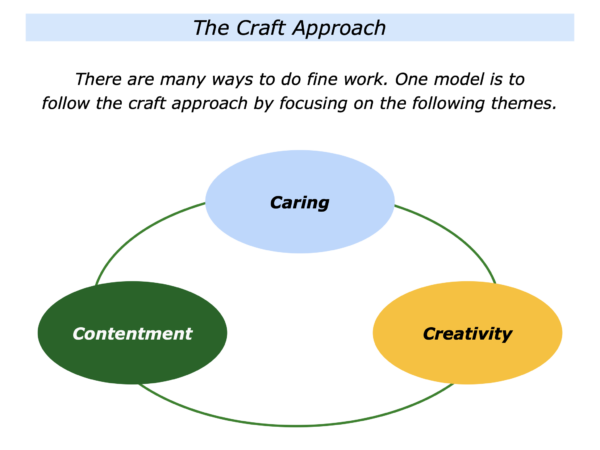
There are many ways to do fine work. One model is to follow the craft approach by focusing on caring, creativity and contentment. Let’s explore these themes.
What are the kinds of work you really care about doing? You may care about encouraging people, solving certain problems, helping people to succeed, building a better world or doing another activity
How can you translate what you care about into pursuing a particular craft? You may aim to do this by working as a counsellor, educator, nurse, writer, film maker, scientist, problem solver, leader or in another role.
How can you do creative work when pursuing this craft? Bearing in mind your strengths, how can you focus on doing a specific project? How can you concentrate and do superb work? How can you use your creativity to find solutions to challenges?
How can you set goals each day and reach these aims? How can you encourage yourself on the journey? How can you finish properly? How can you, if possible, get a feeling of contentment?
How can you rest and reflect? Bearing in mind what you care about, how can you then continue to develop as an educator, coach, mentor, musician or in another role? How can you continue to pursue your chosen craft?
There are many definitions for craft. Originally it applied to making things by hand. More recently it has expanded to include other activities that involve the pursuit of excellence. One definition is:
To create or make something with skill and careful attention to detail.
Imagine you want to follow this path in your own way. Let’s explore some of the themes you may wish to pursue.
Caring
Seth Godin, the author, believes that sometimes it is difficult to find our calling. He recommends instead to focus on the things we care about. Here are some of the themes he explored in his blog.
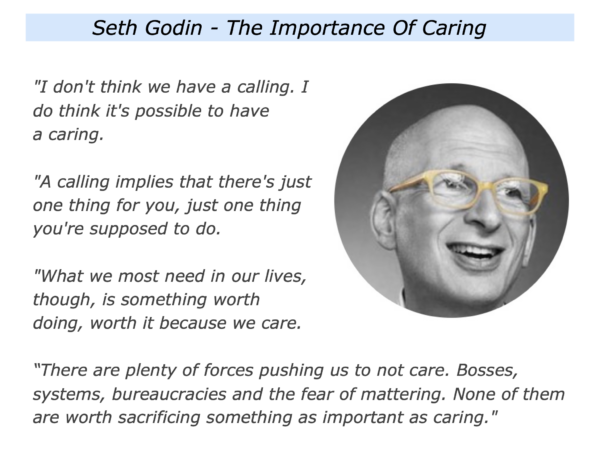
Imagine you want to pursue this path. One approach is to start by clarifying the kinds of work you really care about doing. Different people give different answers when exploring this theme. Here are some of the things they describe.
The Kinds Of Work I Really Care About Doing Are:
Helping people to care for their wellbeing … Creating beautiful things … Writing inspiring music … Making sure everybody has access to clean water … Making films that inspire people to care for nature … Developing technology that empowers people.
If you wish, try tackling the exercise on this theme. Start by brainstorming the kinds of work you really care about doing. Looking at this list, have a go at describing the top three things. Then rate the extent to which you care about these on a scale 0-10.
The next step is to focus on one of these and translate it into doing a specific project. Depending on your chosen path, you may want:
To write an article … To run a series of seminars … To produce a piece of art … To direct a play … To nurture a garden … To coach a youth football team … To perform in a choir … To make a sculpture.
To help people find satisfying work … To renovate a house … To help children with dyslexia … To care for animals … To solve a specific problem … To do another activity.
Imagine that you have focused on one of the activities you really care about and translated this into doing a specific project. You may then want to explore the next step.
Creativity
Imagine that you have clarified what you want to do. You may then aim to do creative work when pursuing your craft.
As mentioned earlier, great workers often do work that involves the heart, head and hands. Their heart loves to do the specific activity. Their head has an understanding – a model or a picture – of what they aim to achieve. Their hands brings something into being.
By hands I mean, in some cases, literally their hands. They may paint, build, fix, type or do another activity. But in other cases it may be using their whole being – their experience, body, voice or whatever to produce a result.
Dave Gamache, a designer and builder, encourages people to follow certain principles to develop their craft. Here are excerpts from a piece he wrote for the lifehacker website.
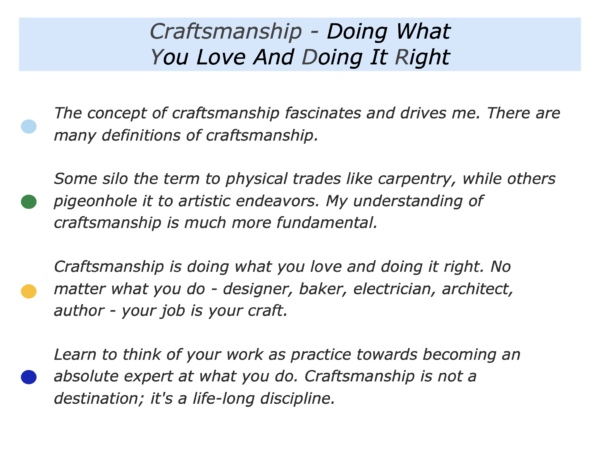
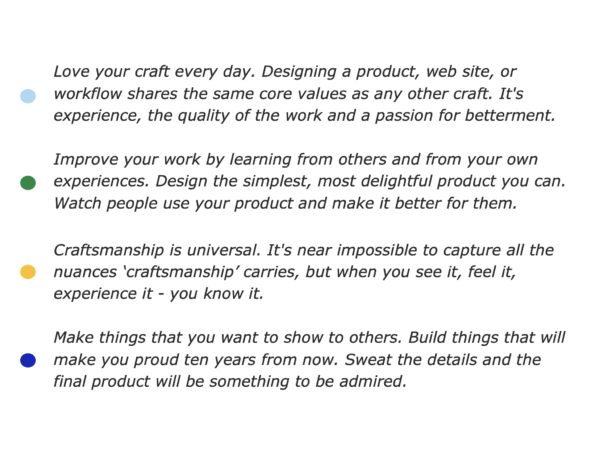
Some people start following this path early in life. They begin by throwing themselves into a particular hobby or interest. They get into the habit of doing this activity deeply and well.
The next stage comes later in life. They settle on a particular passion they want to pursue. They then aim to follow certain principles and master certain skills to achieve their picture of success.
Pursuing this path becomes a lifetime journey. They may aim to become the best they can be as an artist, teacher, designer, mentor or whatever.
Here are some examples from women who have enjoyed this journey and helped others to develop their skills. These are based on their biographies for events celebrating female craftswomen on International Women’s Day.
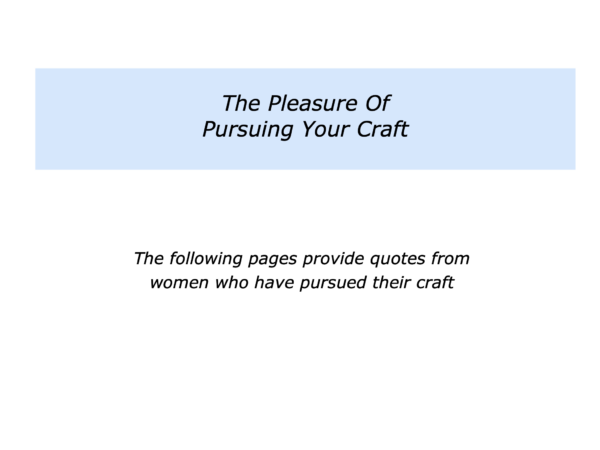
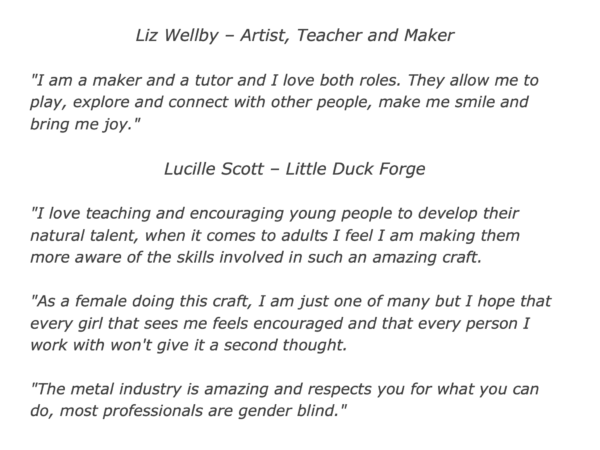
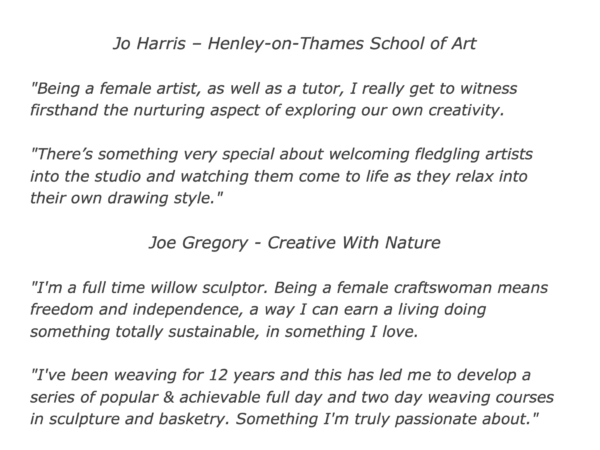
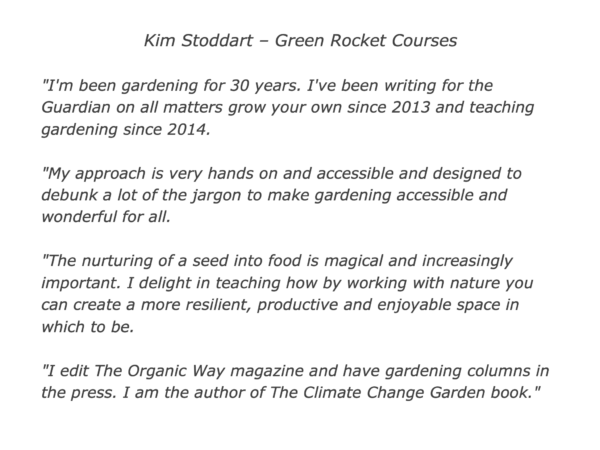
Alan Cooper, a pioneer in computing, described some qualities involved in pursuing a craft. Below are some key points he made in a speech at the Interaction Design Association conference in 2008.
An Insurgence Of Quality
Best to market, particularly in high tech, comes about only through craftsmanship. And craftsmanship is all about quality.
The goal of craftsmanship is to get it right, not to get it fast. The ultimate measurement of craft is not speed. It’s quality. It’s a pure measurement. And a delightful measurement.
Craftsman – craftspeople – do it over and over, until they get it correct. And in their training, in their apprenticeship, they build things over and over.
They learn how to do things correctly, so they can bring enormous expertise to create successful products. Thus the training of craftsman is a long and drawn-out personal process.
Many people have tried to draw a distinction between the arts and crafts. Denis Dutton, the academic and entrepreneur, explored this topic in a Radio New Zealand broadcast in 1990. Below are some of the points he outlined in his talk The Difference Between Art and Craft.
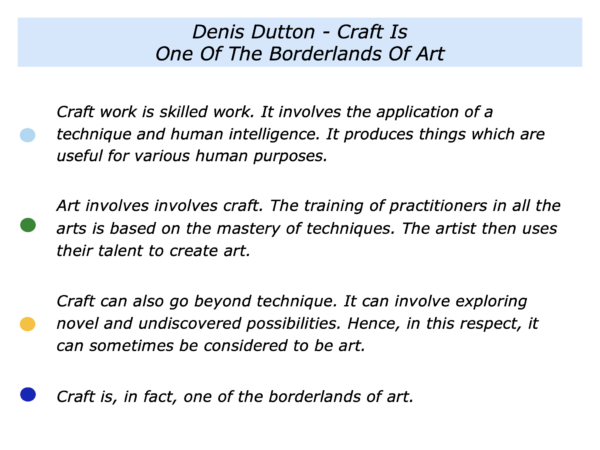
Imagine that you have translated what you care about into pursuing a certain craft and doing a specific project.
How can you set aside time to do the work? How can you rehearse what you are going to do? How can you follow your chosen ritual for beginning the work? How can you set yourself achievable goals?
How can you follow your principles when doing the work? How can you build on your strengths and your skills? How can you continue to be creative and develop your craft on the way towards achieving the specific goals?
Contentment
Imagine that you are pursuing your craft and working towards achieving your goals. As ever, it can be useful to focus on the following steps towards doing superb work.
Strengths. You can build on your strengths and follow your successful style of working.
Strategies. You can set specific goals and clarify the key strategies you can follow to give yourself the greatest chance of success.
Success. You can do superb work, continue to develop and work towards achieving your picture of success.
Pursuing your chosen craft may mean that sometimes you go into what Mihaly Csikszentmihalyi called a state of flow. You become so absorbed in the activity that time goes away.
Different people do this in different ways. Malcolm McCullough described some of the steps that people take in his book Abstracting Craft. Below are themes he describes in the book.
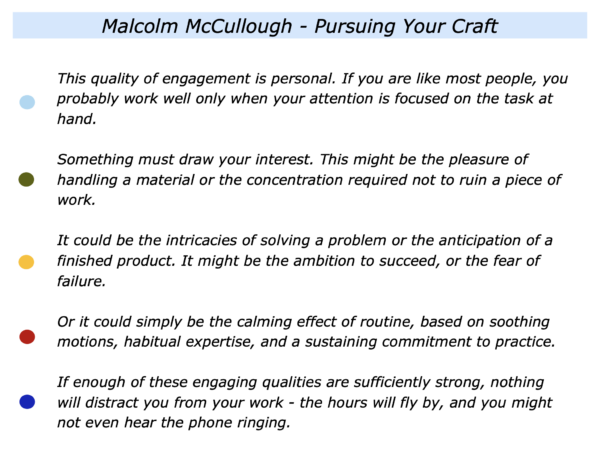
Sometimes you will reach your daily goal and get a feeling of contentment. Sometimes you will enjoy such moments but then turn your thoughts to the next day’s work
This highlights the different drives within a craft worker. They enjoy the journey as well as reaching the goal. They then want to keep improving when pursuing their craft. Contentment can sometimes arrive by accepting and combining these different drives.
It can be the feeling of completeness when seeing their finished product.
It can be the feeling of following their desire to keep developing and making even better finished products.
It can be the feeling of using their talents to make their best contribution during their time on the planet.
Seth Godin believes that, if we focus on the things we care about, we want to keep improving. He described this in the following way.
When we care enough, we raise the bar
Practice alone, the 10,000 hours thing, doesn’t produce work that matters.
No, that only comes from caring. From caring enough to leap, to bleed for the art, to go out on the ledge, where it’s dangerous.
When we care enough, we raise the bar, not just for ourselves, but for our customer, our audience and our partners.
Let’s return to your own life and work. Looking ahead, can you think of an activity where you want to follow elements of this craft approach? How can you do this in your own way?
If you wish, try tackling the exercise on this theme. This invites you to complete the following sentences.
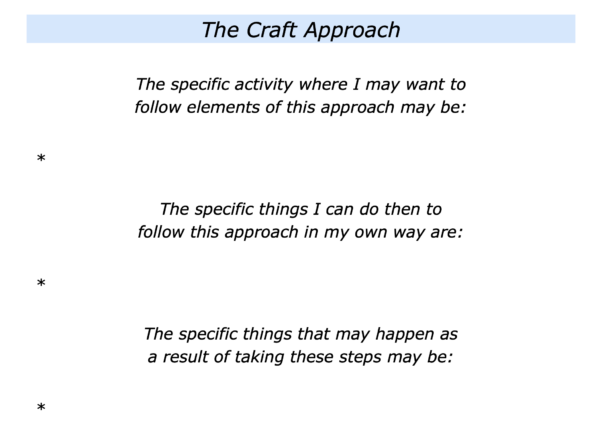






Leave a Reply